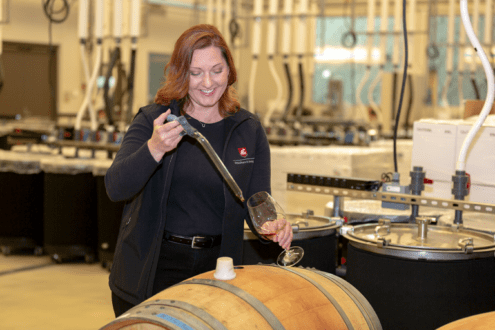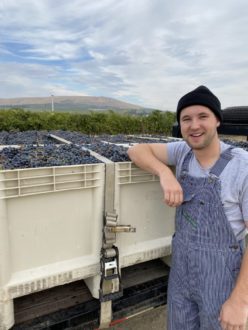Dec 30, 2022WSU student wines blend with holidays
Consumers looking for special wines to celebrate the holidays need search no further than the student-made wines of Washington State University’s Blended Learning class.
The course, which is holding a holiday wine sale, was launched in 2012

“Initially, V&E students were learning mostly just viticulture and enology theory, so I responded by providing them with a true, unique winemaking experience,” Henick-Kling said in a news release. “It has been very rewarding.”
The class name, thought up by one of its first students, is a metaphor for the mix of classroom time and hands-on learning, as well as the literal blending of wine.
Each semester, Blended Learning students decide the types of wine they’ll make, the resources they’ll need, the timeframe and more. Then, working closely with commercial wineries in Washington, they develop high-quality wines from start to finish. Fruit is sourced from various vineyards, helping students learn about the state’s different American Viticultural Areas, or AVAs.


“The industry is very enthusiastic about working with our students,” Henick-Kling said in the release. “We have many requests from winemakers who want to bring them into their wineries and vineyards.”
If a Blended Learning wine turns out well, it’s bottled and sold with the student’s name adorning the label. The sales provide visibility for WSU, and proceeds funnel back into the V&E program, improving it further.
The time of year a student takes the course can determine their experience. The planning process occurs in the spring semester. During the fall, it’s time for harvest and winemaking. The following spring is spent finishing, blending, bottling, labeling, and selling the wine that was made in the fall.
Throughout the year, Blended Learning students serve as ambassadors for the V&E program, traveling to various events like Taste Washington and the Auction of Washington Wines, where they connect with program supporters and those interested in learning more.
Fall semester was Annette Loring’s second time taking the class, and she plans to sign up again next semester.
“I wish I could’ve taken it even more times!” she said in the release.
Loring was pleasantly surprised by the amount of one-on-one attention students receive from Blended Learning professors, and their willingness to share knowledge. She remembers a time when Henick-Kling spontaneously put together a lab after learning about a knowledge gap that students had.
“I don’t know that any other class would’ve allowed for such flexibility,” Loring said in the release. “The faculty are really interested in helping mold us fully.”
Loring’s favorite part of the class was the chance to create her own wine. She’s working on a Malbec that is in barrel now and might still be aging when she graduates in May.
“Going into the vineyard, determining harvest times, getting to know


winemakers, and being fully immersed is an invaluable experience,” said Loring, who is also an undergraduate intern in the WSU Wine Science Center.
Henick-Kling agrees.
“The more firsthand experience, the better,” he said in the release. “When students make the decisions and think it through, a lot of the theory we teach in the classroom starts to make sense.”
Jesse Stevens, who also plans to graduate in May, enjoyed interacting with winemakers and visiting vineyards. Fall semester was his first time taking Blended Learning.
“We learn a lot in class, but it’s also important to get your hands dirty and actually make a tangible product,” Stevens, who created a Cabernet Franc that’s in barrel now, said in the release.
Stevens values the interactions with peers and talented, knowledgeable professors in a setting that’s less formal than a traditional classroom can be. Industry support is also key.
“Having wineries that are willing to support students’ passion for winemaking is impactful,” Stevens said in the release. “There’s a lot of growth going on in the state, and Blended Learning provides a good bridge between the industry and students.”
Henick-Kling envisions a bright, thriving future for the course.
“We have a good program, but there’s an opportunity to make it even better,” he said in the release. “I’d like to see more wine being made and more visibility. We’d like to grow quite a bit.”
PHOTO ON TOP: WSU winemaking student Annette Loring samples a 2018 port-style Blended Learning Syrah that was made by a previous student.














